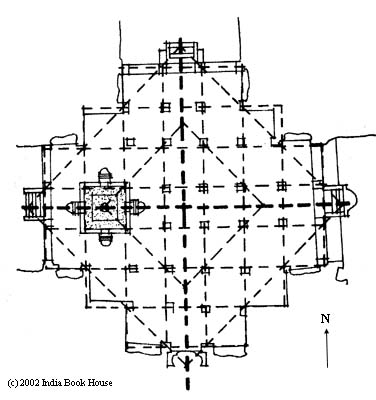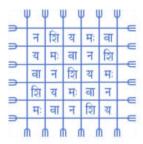Therefore if a King wanted a shaivite, vaishnavite, devi, buddhist, or Jain shrine, they just had to give the orders for it, the rest was taken care of by the Guilds. Hence the characteristic features of each of these temples would be as follows:
Shiva temple (before the Cholas):
- The deities to look for in a Shiva temple would be, the Shiva linga stone within the Garbha griha, which is strictly the aniconic symbol. Shiva in human form is never found within the garbha griha.
- The wall behind the Garbha griha will always have the Lingodhbhavamurti (depicting Shiva's supremacy over Vishnu and Brahma).
- The Vahana is Nandi
- The south wall will always have devi/ Mahishasuramardhini. She was later replaced by Parvati.
- The north wall depicts either Ganesha and Karthikeya or other forms of shiva like Dakshnamurti, Trimurti or Harihara(this order changes from temple to temple). Older temples depict only Shiva on all walls. The devi in the form of Parvati is depicted standing with him (Kalyanasundaramurti) or ardhanarishwara, else she is depicted as Durga/Kali dancing with Nataraja.
- The others: Saptamatrika only in ancient temples, Bhringi on some walls but not in a niche, Chandikeshwara, Rudra, Ganesha, and Karthikeya in separate shrines if they are not on the niches of the main sanctum.
- If there are depictions of Vishnu and Brahma, they would be in praise of Shiva or in submission. The only exception with any reference to the Ramayana is Ravana Anugrahamurti where Ravana is depicted shaking mount Kailasa.
- Nayanars take their place on the precinct.
- 108 lingas are placed in a single location or around the main shrine.
Vishnu temples:
- The dashavatara is found on all the exterior walls of a Vishnu temple, as well as on the pillars.
- Large depictions in older temples would include Trivikrama/Vamana, Narasimha, Vishnu seated on Ananta.
- Vishnu within the shrine chamber(garbha griha) is depicted lying on Ananta in the cosmic sea, else he is depicted standing in Samabhanga pose (standing straight backed with hand resting on mace).
- Vahana is Garuda
- Devi is often depicted with him in the Varaha form.
- Krishna is very rarely depicted, if at all as Krishna Govardhana and krishna stealing butter.
- Scenes of the Ramayana adorn the outer walls, but do not occupy the niches. Exception is for the Ravana Anugrahamurti where Ravana is depicted shaking mount Kailasa.
- Icons of Shankha and chakra can be seen around the temple.
- Garuda and nagas are often depicted, nagas specifically are in submission.
- Hanuman is sometimes depicted in Vishnu temples.
- Alvars are depicted on the temple walls and pillars.
- Mostly depict various forms of the Devi, in soumya(soft) rupa and krodha(fierce) rupa.
- The central shrine is either Bhuvaneshwari (soumya rupa) or Durga/ Kali(fierce form)
- All devis in shrines mostly face south, be it from garbha griha, or in niches of shiva temples.
- Very prominent scenes in ancient temples would be the scene of decapitation where a devotee is seen chopping his own head and sacrificing his life to the Mother. (Orissa, Mamallapuram)
- Copulation scenes on the outside of temples, or alternatively Kanyas in seductive poses. (Konark and khajuraho)
- Very rare depictions of Shiva lingas, which is almost close to negligible.
- Vahana is a lion.
- Walls are adorned by worshippers, both royal and common folk.
- Buddha depicted in certain mythological events like Miracle of Sravasti(buddha multiplies himself a 1000 times to beat his religious rivals including Mahavira), Parinirvana(Buddha in the state of Nirvana), Temptation of Mara(Buddha attacked by the three damsels and a whole demon army sent by Mara), Buddha begging alms from his wife. Most often depicted are Buddha giving a sermon or standing.
- Profusely painted on walls are the Jataka tales of Buddha's past incarnations.
- Padmapani and Maitreya come in later.
- There are no vahanas.
- Older Hinayana phase elements to look for are stupas, pair of slippers, pair of feet, and a bodhi tree with a pair of feet beneath it.
- Hariti and Panchika, where hariti has a child on her lap. She is the Goddess of smallpox, a child eating ogress whom Buddha converted into a protector. Panchika is her consort and also very well known as Kubera yaksha.
- Jain tirtankaras and more tirtankaras.
- Gomateshwara and parshvanatha are a vew well known tirtankaras who can be seen in the Garbha Griha and on the walls of the cave temples.
- Sculptures are mostly nude.














